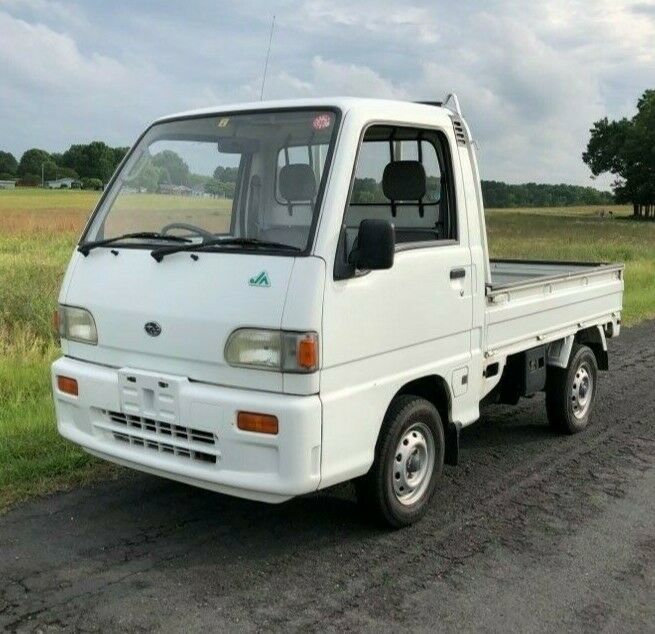Japanese Farm Trucks – A better way to farm
Japanese Farm Trucks are one of the easiest Kei trucks to import. Because the vehicle will be used for agricultural purposes, most states allow for newer Kei trucks to be imported. This means that you can have a new Suzuki Carry, Daihatsu Hijet, or Subaru Sambar. Many other brands are also available with packages specifically for farming and off-roading. If you have ever wondered what Japanese Farm Trucks can do for you, read on.

The size benefits
Many look at a Kei truck and think that it is too small to be an effective working truck for a farm. However, this is not the case. The Kei truck allows you to have, on average, 1500 lbs of supplies, hay, or other cargo in the bed. They can accomplish security of the load with the liftable sides of the bed. On most Kei trucks, the sides fold down all around, allowing you quick access, regardless of the position of the truck. The size of the truck makes positioning the vehicle easy, allowing you to have better control over the bed’s contents. Unlike the full-sized vehicle, the small size of the Japanese Farm Truck is intentionally designed for off-road agricultural purposes.
Two big advantages
Besides the versatility of the bed of the truck, there are full-size considerations. First, the small size allows for you to navigate areas where a full-sized farm truck could not go. For example, you could not get a fully loaded F-150 onto some trails without major damage to the truck’s exterior. A Kei truck can navigate most passages without having to worry about scratching up the sides, scraping the top against limbs, etc.
Second, the small truck allows for a lighter overall weight. This allows you to travel with minimal drag. It also allows you to have a higher weight load than an ATV or other small off-road vehicle. Last, the small size makes the truck portable. This means that they are small enough to tow with ease. Why would this be a benefit? It is a benefit because it allows the truck to be carried on-road to various farming locations where its small size can be used.
Japanese Farm Truck Navigation
While the navigation of the Kei truck is suitable for farming, you might have your Kei truck lifted. A lifted Japanese Kei Truck can give you a bit more space for the dips and hills common to farmland. Lifting your Kei truck also gives you a bit more room for thicker tiers. This is not a necessity, though. The build of the Japanese Farm Truck allows you ample navigation functions. Most Kei trucks can climb 20ᵒ inclines with ease. But, if you have a lifted Japanese truck, there is an increase in the safety of your crop.
Most lifts are only 2 inches to 6 inches. This does not sound like much, but when you consider how low to the ground crops grow, you can see the benefit. The Kei truck, though already up high enough to clear most crops, can be lifted to fully clear them. This allows for the truck to navigate between crop rows damaging none of the harvests.
Full-sized trucks may navigate between rows. However, the larger size and weight damage the harvest area. Because the full-size vehicle is larger and more cumbersome, turn radiuses are increased, making it a hassle and a threat to end row harvests. Most times, the vehicle cannot go into the field safely, making the farmers walk to the location. Depending upon the spacing of the rows, a Kei truck may drive the rows safely.

Uses for a Japanese Farm Truck
Primarily, the Japanese farm truck will be used for harvesting crops and for hauling the tools and supplies to a location. There are other uses for the Japanese Mini truck. A few of these uses include:
Livestock transport
Kei trucks can quickly be converted into vehicles that can transport small to medium-sized livestock. Because the sides fold down, kennels and cages can be loaded with ease. This means that if you have, for example, chickens that you need to carry, you can do so with the truck without the need to retrofit the bed. Simply load them up and go.
Land Clearing
Farming will require that you have land cleared in order to plant crops. If you are clearing a plot of land, you could have the Kei truck fitted with a dump bed. This turns the truck into a dump truck and allows you to quickly carry and dispose of debris. Full-sized dump beds are expensive and can damage the land. Fitting your Japanese farm truck for a dump bed keeps the land safe and the costs to clear low.
Feeding and maintenance
There are several tasks that are performed on a farm. These range from feeding the animals to ensuring that the pens are cleaned daily. Using a Kei truck to haul the supplies and perform these tasks is essential to keeping the maintenance and the cost of operations low. The fuel efficiency of the Kei truck ensures that you can perform feeding and maintenance at a low cost. The size of the Kei truck allows you to access these areas without disturbing the animals or damaging the ground.
These are just a few of the many tasks that a Japanese Farm truck can perform. If a full-size truck can do the task, a Kei truck can also perform it.
Getting a Japanese Farm Truck
Because you will use the truck for agricultural purposes, you can import most Kei trucks on the market. If you intend to use the vehicle for both farming and on-road use, ensure that you get a Kei truck that is 25 years old or older so that you can claim classic vehicle status. Check with your local and state registration for specific standards and regulations concerning the importation of your Kei farming vehicle. Japanese farm trucks are an efficient and cheap way in which to add to your farming.

